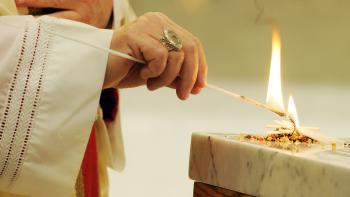In April of 1964, Bishop Joseph McShea, the First Bishop of the Diocese of Allentown, blessed the cornerstone of Sacred Heart Church in Bethlehem. In the ensuing 60 years, the church devotedly served the faithful in the Miller Heights section.
On April 28, 2024 – the very anniversary of the dedication of Sacred Heart Church by Bishop McShea and pastor Father Francis X. Gilly – Bishop Alfred Schlert, the Fifth Bishop of Allentown, dedicated a new altar for the church.
The rite was performed at a Solemn Pontifical Mass of Dedication celebrated by Bishop Schlert and concelebrated by Father Frans Berkhout, pastor of Sacred Heart, Bethlehem, and Father John Frink, parochial administrator of St. Francis de Sales, Robesonia. The three are all classmates, ordained in 1987.
“I could not find an altar that was an appropriate fit for our church,” Father Berkhout told the congregation of more than 300. “Father John [Frink], a master carpenter, offered to handcraft a new altar using wood from pews that were removed from the church years ago.”
As part of the dedication Mass, the impeccably carved altar was sprinkled with water that Bishop Schlert had blessed during the Introductory Rites. In place of general intercessions, the Litany of Saints was sung, with the particular invocation of St. John Paul II, St. Teresa of Calcutta, St. Margaret Mary Alacoque, St. Pius X, St. John Neumann, St. Anthony of Padua, and St. Francis of Assisi, the saints whose relics would be deposited in the new altar.
Immediately after the litany, the Bishop placed the relics in a cavity at the top of the altar, and a team of stonemasons set the 800-pound altar slab, or “mensa,” in place.
The first-class relics are: St. John Neumann, “ex ossibus” (from the bone); St. Pius X, “ex carne” (the skin/flesh); and St. Teresa of Calcutta, “ex capillis” (hair). Second class are: St. Anthony, St. Francis, St. John Paul II, St. Margaret Mary, “ex indumentis” (clothing).
After a Prayer of Dedication, the rites of anointing, incensing, covering, and lighting the altar were performed, giving visible expression to the invisible work accomplished through the celebration of the Eucharist.
After pouring Sacred Chrism on the center and four corners of the mensa, the Bishop anointed the entire surface of the altar. Incense and a taper were then set down on each of the five points where the Chrism had been poured, symbolizing Christ’s five wounds. The subsequent lighting of the tapers by the Bishop represented the rising to God both of Christ’s sacrifice and of the people’s prayers.
While Father Philip Maas, assistant pastor of St. Thomas More, Allentown, chanted the antiphon “Stetit Angelus” (“The Angel Stood”), Bishop Schlert blessed the altar with incense, which is a symbol of Christ, and the people, who are living temples. Afterward, the altar was wiped and dressed in altar linens.
The lighting of the altar candles, a reminder that Christ is a light to all nations, concluded the preparation of the altar for the principal part of the whole rite: the celebration of the Eucharistic sacrifice.
“The altar, going back to Old Testament times, to the Jewish priesthood, was a location of sacrifice,” noted Bishop Schlert. “That’s why I like to call it an altar and not just a table, because it truly is a place of sacrifice, wherein Jesus, once again, is sacrificed on the Cross and in an unbloody manner. We have present for us at that altar His Body, His Blood, His Soul, and His Divinity.”
“That’s why this altar is the heart of this parish, along with the tabernacle. It’s not a slab of marble, not a piece of wood, not just a table, but an altar wherein Jesus becomes present each and every time.”








